Egypt
Luxor
Tuesday morning – Happy Birthday – our ship is 1-month old today! Our ship arrives at the Egyptian Port of Hurghada in the Red Sea. A pilot boat with Customs and Port Officials arrives and it takes about 90 minutes to get clearance for us to leave the ship. These types of official procedures are rather untested since no tourist ships have been landing for over two years. Finally, we exit the ship with only a small overnight size bag and board buses for the overland journey to The Valley of the Kings. Along the way, we travel with our local guide, Hoda, an Egyptian woman educated in Egyptology. The Port of Hurghada is not crowded. It is on the edge of the desert on the Red Sea and serves as a resort area with good schools and hospitals, and 360 days of sunshine. In Egypt, school mandatory until the 9th grade. The plan was to be on the buses by 7am, but we are running ~2-hours late. Normally, the bus trip would take ~3-4 hours to get to the Valley of the Kings, followed by lunch and a visit to the Luxor Temple. However, increase traffic and multiple police checkpoints slow our progress and the trip takes ~5.5-hours. Along the way we crossed the Red Sea mountains and miles of desert before arriving into the Nile Basin which is green and a huge agricultural area. At the “green” Nile area, there is no rain and all crops are grown with hand-dug irrigation canals from the Nile. Here, they grow large crops of sugar cane & bananas. Luxor is the lower part of Upper Egypt. In this part of Egypt, women go to school to learn to read & write through 9th grade before 50% of them go into the fields to work. Twenty years ago, there were no women with a higher or university education. We finally reach our hotel which is located a short distance from the Nile River in the middle of town.
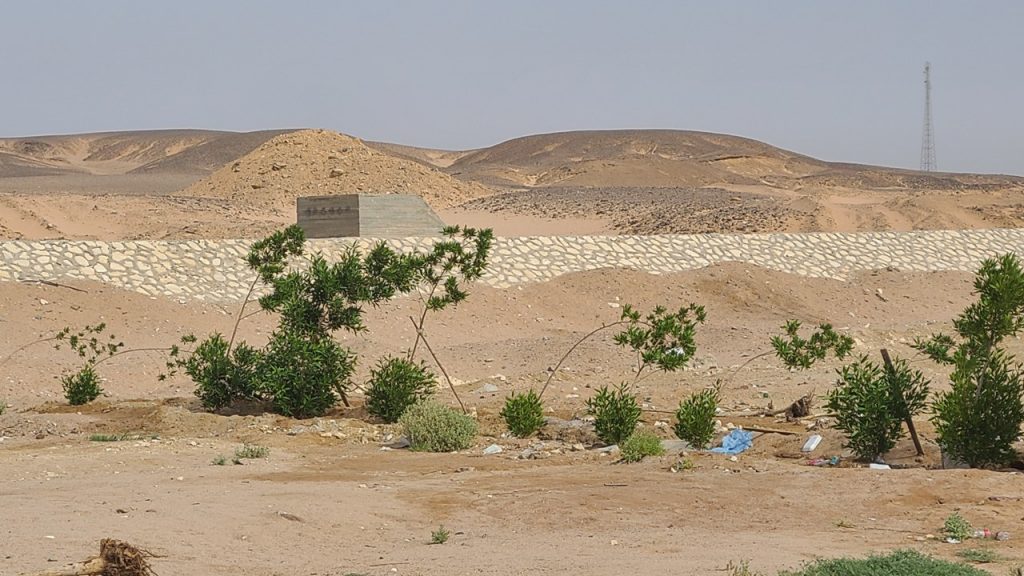
For local shopping in Egypt, one needs to use Egyptian pounds, and luck for us there was an ATM outside the entrance of the hotel. $1= 25 Egyptian pounds.
After freshening up, we met again for a short trip to the Luxor Temple which was built as part of the “New Kingdom”. We explored the Temple on our own before walking part of the “Avenue of the Sphinx” which is still being uncovered and excavated. The 1.7 mile avenue is lined by over 1000 sphinx’ that connect the Luxor Temple to the Temple of Karnak, It was then back to the hotel for dinner and a toast to having made it here after a long day of travel. A toast of “Cheers” is “ Fe Sahetek” in Egyptian.
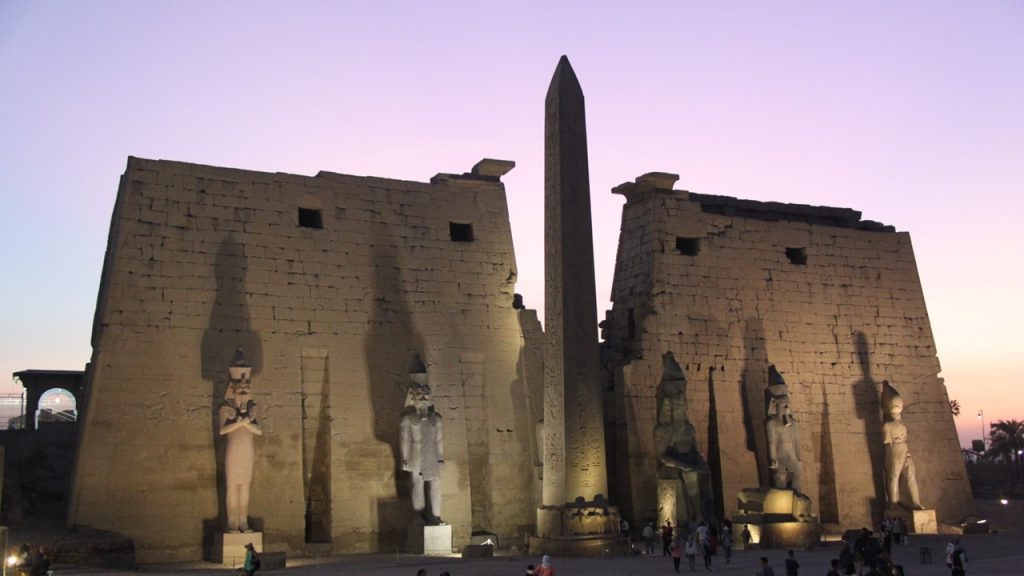

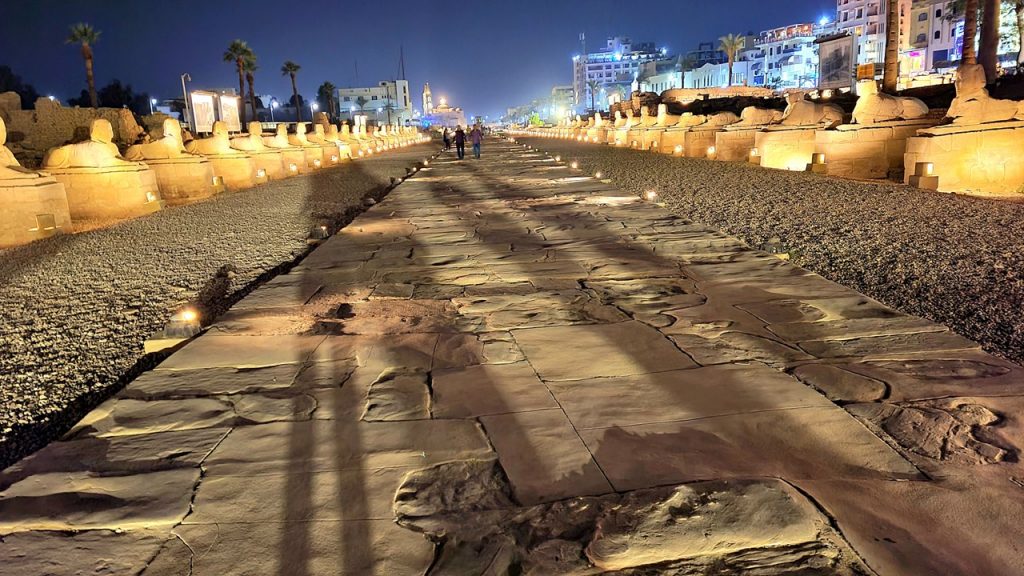

Ancient Egyptian History
5000BC-3500BC
The New Stone Age: The Ancient Egyptians discovered the use of copper tools & started to move closer to the banks of the river Nile. There, they cultivated the land & become farmers, fishermen, and shepherds as they domesticated animals and were no longer just hunters.
3500BC-3100BC
The provinces (nomes) of the Egypt’s Nile Delta area of the North united and formed the “Kingdom of Lower Egypt”. Meanwhile, the provinces of the South along the Nile Valley unified and formed the “Kingdom of Upper Egypt”.
3100BC
This marks the unification of Upper & Lower Egypt by a King known as “Mena”. Mena was the King of Upper Egypt and he defeated the Lower Kingdom Egyptians and founded the first capital of a united Egypt in Memphis, which is considered by historians as the beginning of the Ancient Egyptian History. At the same time, the making of paper out of papyrus plant was discovered. The next ~3000 years of Ancient Egyptian History was divided into 30 Dynasties which were later grouped into periods. The periods of unity and power with a centralized government are called Kingdoms and there were three of them:
- ➢The Old Kingdom:( Known as the “Age of Pyramids”) 3rd-6th Dynasties 2686-2181 BC
- ➢The Middle Kingdom:(The Agricultural Period) 11th &12th Dynasties 2033-1786BC
- ➢The New Kingdom:(the “Egyptian Empire”) 18th-20th Dynasties 1567-1080 BC
The intervening periods of disorder that caused the collapse of these different kingdoms were principally due to either foreign occupation or because of civil wars. These were known as “Intermediate Periods” and there were 3 of them – the 1st, 2nd, & 3rd Intermediate Periods.
The pyramid-shape was important to ancient Egypt as it was believed that enabled the dead to journey to sun and everlasting paradise. This was the path to immortality. The Old Kingdom was marked by very large pyramids reserved for pharaohs and their queens, where the Middle Kingdom was marked by many smaller pyramids that included a larger cross-section of society’s nobility. Most pyramids and tombs were eventually robbed leaving only those that were never found intact. During the New Kingdom, most tombs were moved to the area in the south including Egypt and Sudan. After the ancient Kingdoms, Egypt fell under a series of foreign rulers and religious influences.
332BC (Greek Rule-Hellenistic Period)
Alexander the Great conquered Egypt and founded Alexandria City to serve as a new maritime capital of Egypt. After his death, his general, Ptolemy, and his successors ruled the country for the following 300 years, ending with the death of Cleopatra VII.
30 BC (Roman Rule)
Mark Anthony & Cleopatra VII were defeated by Octavian at the battle of Actium and both committed suicide. Subsequently, Egypt became a province of the Roman Empire.
58AD (Christianity)
Christianity entered Egypt through the work of St. Mark, the evangelist.
641 AD ( Islam)
Moslem armies led by Amir Ibn El As conquered Egypt, which began the Arabic & Islamic Period.
Valley of the Kings
Wednesday, we were up for breakfast and took a 30-minute trip across the Nile to its West Bank side and to the Valley of the Kings. Today, there are more than 90 tombs already discovered in this area. We acquired ticked that allowed us to visit any three open tombs.
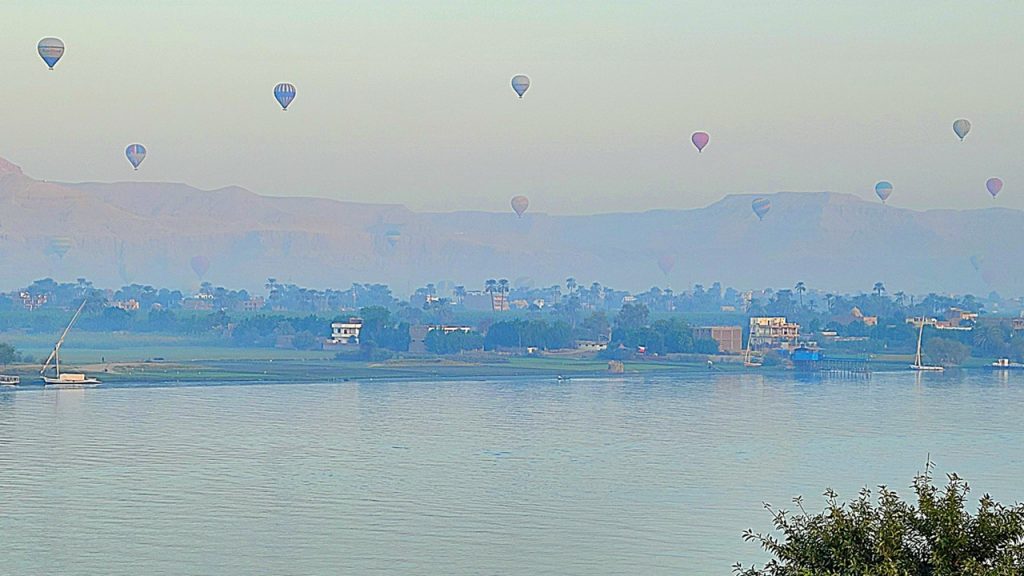
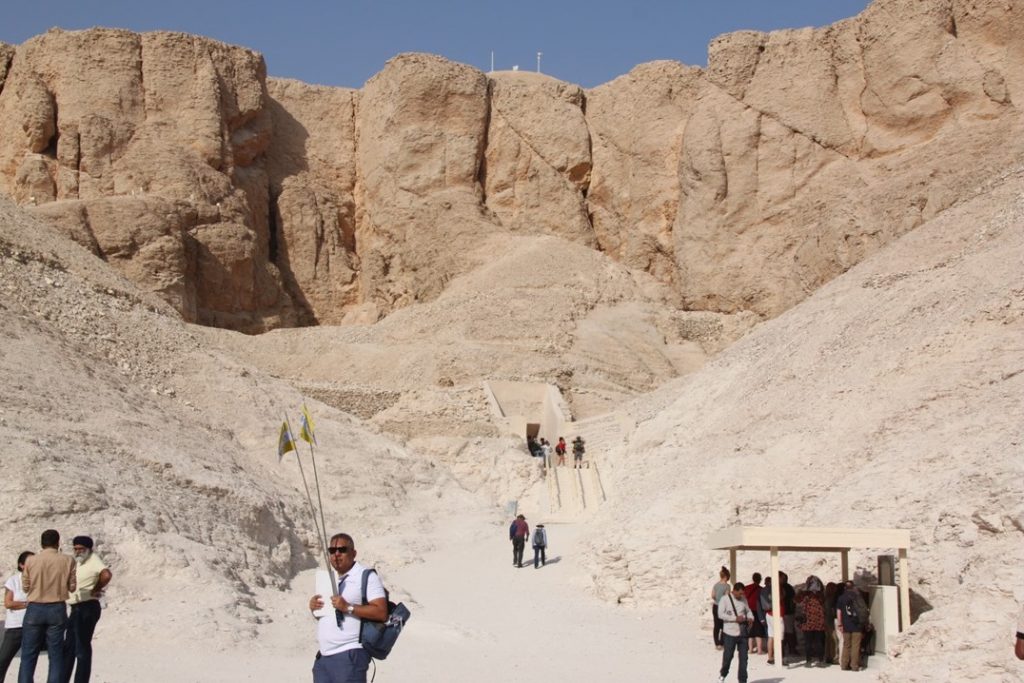
Before using our tickets, we first visited the tomb of Ramses IX that is built during the 20th Dynasty under a pyramid-shaped mountain with a shaft entrance from the side. This was believed to have been done to help disguise its location and hinder any tomb robbing. Unfortunately, any records indicating where these tombs were located were not kept, and other subsequent tombs often ran into previous chambers when being dug, and the diggers would simply turn and continue to dig. This is what happened in this tomb and there is a sealed off wall and a turn along the entryway. The tomb’s owner is always inscribed with a cartouche in the front that also tells which kingdom he ruled. Ramses IX ruled both the North and South Kingdoms. This tomb had been opened since antiquity and has a large pit in the floor of the burial chamber. The hieroglyphs on the passageways include the Book of the Earth, the Book of the Day, the Book of the Night, and the Book of the Dead which depict the deceased’s journey to the afterlife.
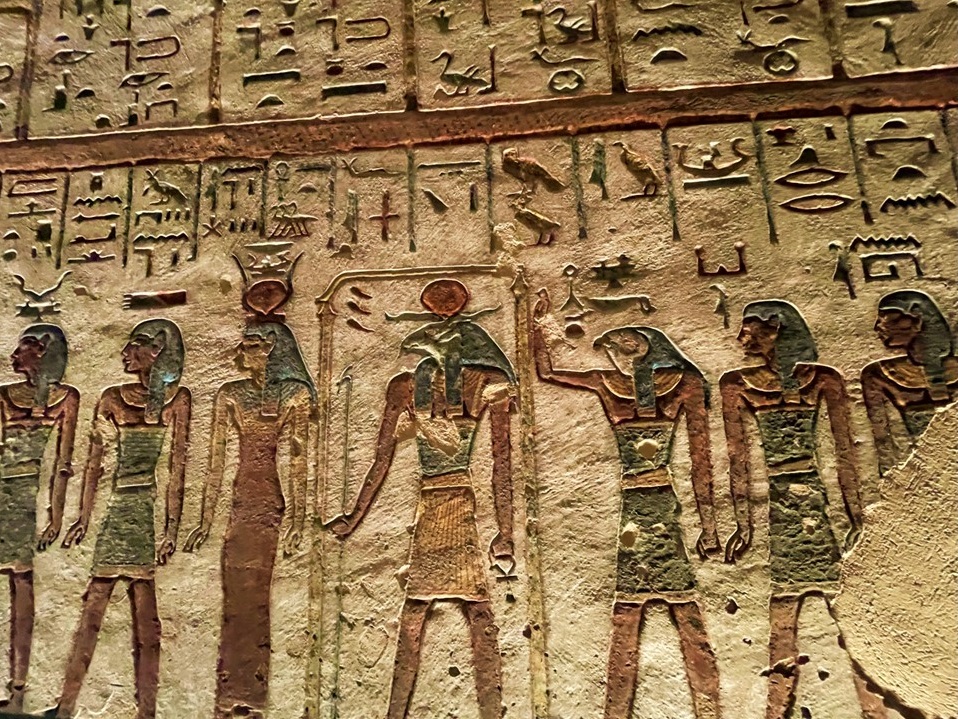
We made our first choice and visited the tomb of Ramses III also built during the 20th Dynasty and also open since antiquity times. This tomb has a long, straight passage and a series of rooms with two pairs of animal-headed pilasters at its entrance. It also was shifted during construction because of running into another tomb during construction. These walls are decorated with the similar scenes and hieroglyphs as that of Ramses IX.
Next, we visited the famous tomb of Tutankhamen, which required a special ticket and enforced a limited number of entrees. Tutankhamen reigned for 10 years from 1333 to 1323 before he died at the age of 19. An existing tomb was hastily adapted for him and remained undiscovered until 1922, when 5-years of searching by Howard Carter and Lord Carnarvon resulted in success. Today, only the mummy of the king, the outermost of his three nested coffins, and the stone sarcophagus and its lid remain in the tomb, and all other objects found there are removed to museums in Cairo, including the solid gold inner-most coffin. This tomb makes clear the preserved vivid colors of the wall decorations and the impressive artistic ability of its creators.
For our second choice, we visited the tomb of Ramses V/VI, another 20th Dynasty tomb that had been open since antiquity times. This tomb was begun for Ramses V but was taken over and completed for Ramses VI and includes a pit in the floor of the sarcophagus chamber. The wall decorations here are in remarkably good condition.

Finally, for our third choice of tombs, we entered the tomb of Merenptah from the 19th Dynasty. The upper chamber had been open since antiquity, however, the lower corridors and chambers were discovered and cleared by Howard Carter in 1903-1904. This tomb used four sarcophagi and had extensive and beautiful wall decorations and the outer sarcophagus in place.
Temple of Queen Hatshepsut
After some quick shopping, we made the very short trip to the elegant funeral and mortuary temple at Deir al-Bahri of Queen Hatshepsut who ruled Egypt as its most successful female pharaoh. The temple is carved into a rock cliff and is flanked by symmetrical, colonnaded wings and a long, terraced, processional walkway. Hatshepsut was Egypt longest reigning Queen and ruled over one of the most peaceful and prosperous periods of Egypt’s history. Queen married her half-brother; however, she allowed him to have a concubine who had a son, The Queen hid the child and ran the land as a King for 20 years. When she died, her husband removed all her cartouches and hid her burial temple as part of a walled garden. But history documented her reign.
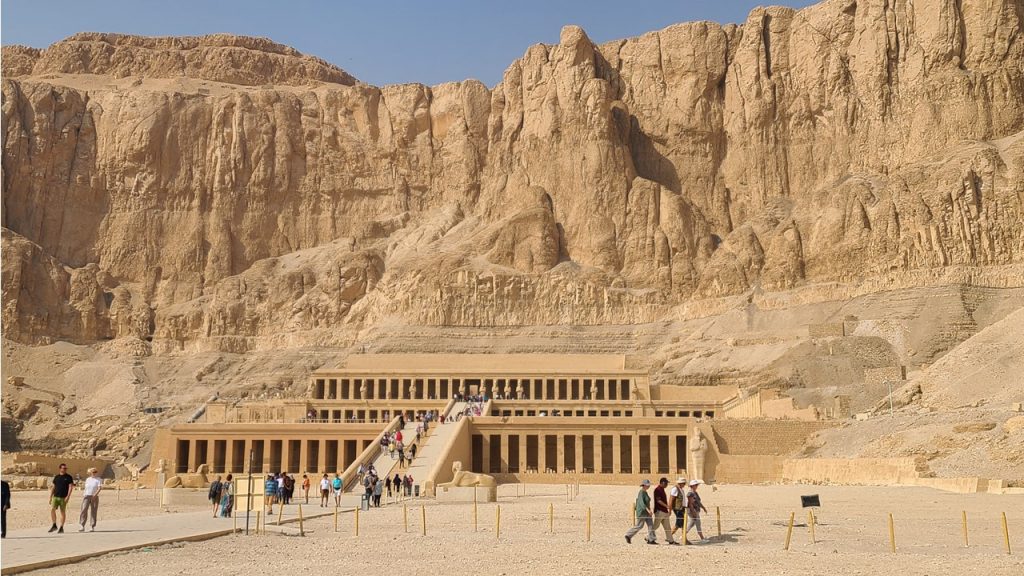
After leaving the temple, we traveled another short distance before stopping at the Colossi of Memnon and Temple of Amenhotep III, which was undergoing conservation and preservation. These colossal statues are 60 ft. tall and are impressive guardians of the surrounding area.

Then, after examining the Colossi, we headed back to city of Luxor, and stopped at the Georgina Nile River Restaurant – a barge turned restaurant docked on the side of the Nile river where we had lunch overlooking the graceful traditional Dahabiya (2 sails) and Feluccas (1 sail) sailing boats. After lunch, we returned to the hotel for an afternoon of rest followed by drinks at the poolside veranda before leaving for an evening sound and light show at the Karnak Temple.
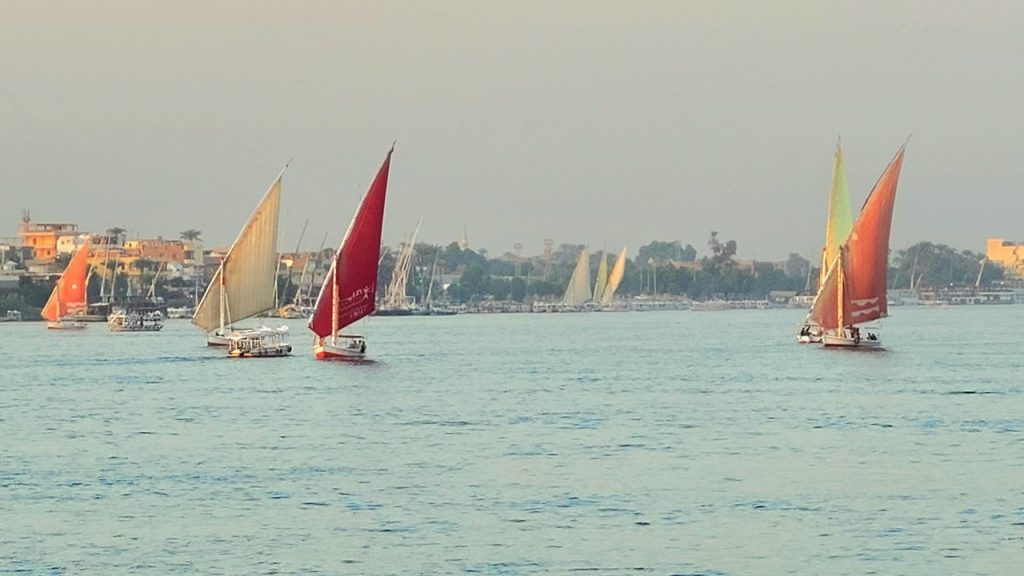
Temple of Karnak
The Karnak Temple is at the other end of the Avenue of Sphinx’ and was built with huge stones dragged there to build the 145 columns and obelisks. The Karnak Temple is considered one of the most beautiful Egyptian temples. The nighttime light show walks one through the temple section-by-section telling the story of Amman through time up to the reign of Tutankhamen. After the show, we traveled by bus to the nearby New Hamees Papyrus shop where they still create papyrus sheets by hand using traditional methods. Their stable of local artists create unique art with them, and we purchased a painting to add to our collection. Then, it was time to head back to the hotel for a late dinner before packing for our early departure in the morning.
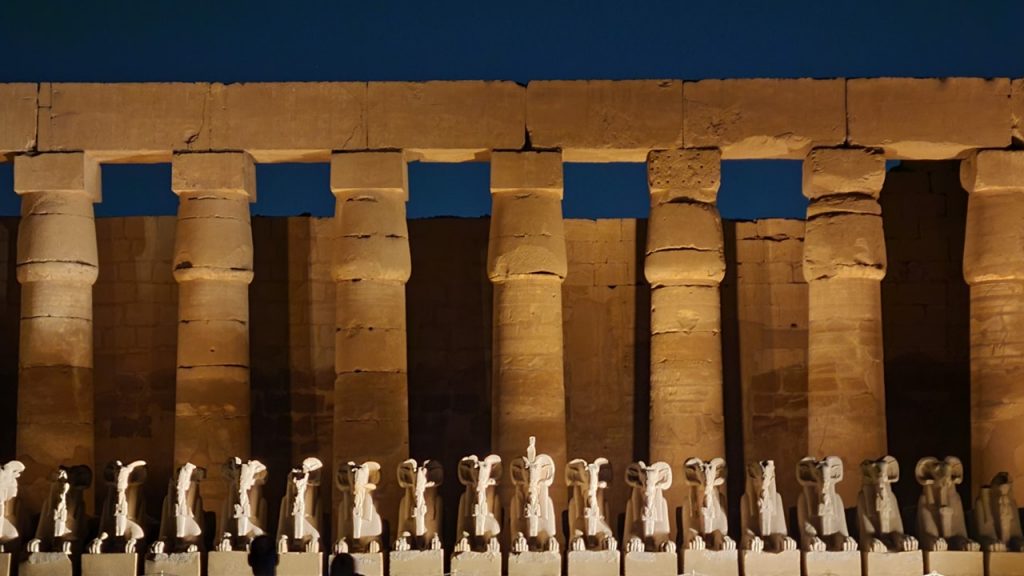


The next morning, Thursday November 24th, our trip back to the ship is quicker and we arrive at a different port – the city of Safaga. This is principally a commercial shipping port, but has aspirations of becoming a resort one day. Currently, the area is supported by phosphate mining, but the area’s 360 days of sunshine per year could make it a therapeutic area for spa treatments, skin therapy, and arthritis remedies.
We board the ship at 1pm just in time for lunch, and the ship immediately sets sail for the 5-day trip to Oman.
